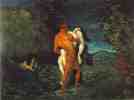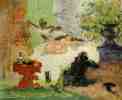![]()
Paul Cézanne (1839-1906) is certainly as great an artist as any that ever lived, up there with Titian, Michelangelo, and Rembrandt. Like Manet and Degas, and also Morisot and Cassatt, he came from a wealthy family -- his was in Aix-en-Provence, France. His banker father seems to have been an uncultivated man, of whom his highly nervous and inhibited son was afraid. Despite parental displeasure, Cézanne persevered with his passionate desire to become an artist. His early paintings display little of the majesty of his late work, though today they are rightfully awarded the respect that he certainly never received for them.
His early years were difficult and his career was, from the beginning, dogged with repeated failure and rejection. In 1862 he was introduced to the famed circle of artists who met at the Café Guerbois in Paris, which included Manet, Degas and Pissarro, but his awkward manners and defensive shyness prevented him from becoming an intimate of the group. However, Pissarro was to play an important part in Cézanne's later development.
 Portrait of the Artist's Father
Portrait of the Artist's Father
c. 1866 (170 Kb); Oil on canvas, 198.5 x 119.3 cm (78 1/8 x 47 in); National Gallery of Art, Washington, D.C.
One of the most important works of his early years is the portrait of his formidable father. The Artist's Father (1866, 199 x 119 cm (78 x 47 in)) is one of Cézanne's ``palette-knife pictures'', painted in short sessions between 1865 and 1866. Their realistic content and solid style reveal Cézanne's admiration for Gustave Courbet. Here we see a craggy, unyielding man of business, a solid mass of manhood, bodily succint from the top of his black beret to the tips of his heavy shoes. The uncompromising verticals of the massive chair are echoed by the door, and the edges of the small still life by Cézanne on the wall just behind: everything corresponds to the absolute verticals of the edges of the canvas itself, further accentuating the air of certainty about the portrait. Thick hands hold a newspaper--though Cézanne has replaced his father's conservative newspaper with the liberal L'Evénement, which published articles by his childhood friend, Emile Zola. His father devours the paper, sitting tensely upright in the elongated armchair. Yet it is a curiously tender portrait too. Cézanne seems to see his father as somehow unfulfilled: for all his size he does not fully occupy the chair, and neither does he see the still life on the wall behind him, which we recognize as being one of his son's. We do not see his eyes-- only the ironical mouth and his great frame, partly hidden behind the paper.
Cézanne was in his twenties when he painted The Artist's Father. Wonderful though it is, with its blacks and greys and umbers, it does not fully indicate the profundity of his developing genius. Yet even in this early work, Cézanne's grasp of form and solid pictorial structures which came to dominate his mature style are already essential components. His overriding concern with form and structure set him apart from the Impressionists from the start, and he was to maintain this solitary position, carving out his unique pictorial language.
 The Abduction
The Abduction
1867 (120 Kb);
Oil on canvas, 89.5 x 115.5 cm (35 1/4 x 45 1/2");
Fitzwilliam Museum, Cambridge, UK
Abduction, rape, and murder: these are themes that tormented Cézanne. Abduction (c. 1867, 90 x 117 cm (35 x 46 in)), an early work full of dark miseries, is impressive largely for its turgid force, held barely under his control. These figure paintings are the most difficult to enter into: they are sinister, with passion in turmoil just beneath the surface.
Cézanne's late studies of the human body are most rewarding, his figures often depicted as bathers merging with the landscape in a sunlit lightness. This became a favorite theme for Cézanne and he made a whole series of pictures on the subject. This mature work is dictated by an objectivity that is profoundly moving for all its seeming emotional detachment.
It was before nature that Cézanne was seized by a sense of the mystery of the world to a depth never expressed by another artist. He saw that nothing exists in isolation: an obvious insight, yet one that only he could make us see. Things have color and they have weight, and the color and mass of each affects the weight of the other. It was to understand these rules that Cézanne dedicated his life.
 A Modern Olympia
A Modern Olympia
c. 1873-74 (210 Kb); Oil on canvas, 46 x 55.5 cm (18 x 21 3/4");
Musée d'Orsay, Paris
From 1872, under Pissarro's influence, Cézanne painted the rich Impressionist effects of light on different surfaces and even exhibited at the first Impressionist show. But he maintained his concern for solidity and structure throughout, and abandoned Impressionism in 1877. In Le Château Noir, Cézanne does not respond to the flickering light as an Impressionist might; he draws that flicker from deep within the substance of every structure in the painting. Each form has a true solidity, an absolute of internal power that is never diminished for the sake of another part of the composition.
It is the tension between actuality and illusion, description and abstraction, reality and invention, that makes Cézanne's most unassuming subjects so profoundly satisfying and exciting, and which provided a legacy for a revolution of form that led the way for modern art.
The special attraction of still life to Cézanne was the ability, to some extent, to control the structure. He brooded over his apples, jugs, tables, and curtains, arranging them with infinite variety. Still Life with Apples and Peaches glows with a romantic energy, as hugely present at Mont Sainte-Victoire. Here too is a mountain, and here too sanctity and victory: the fruits lie on the table with an active power that is not just seen but experienced. The jug bulges, not with any contents, but with its own weight of being. The curtain swags gloriously, while the great waterfall of the napkin absorbs and radiates light onto the table on which all this life is earthed.